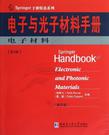电子与光子材料手册 第三册
出版时间:2013-1 出版社:卡萨普 (Safa Kasap)、 卡珀 (Peter Capper) 哈尔滨工业大学出版社 (2013-01出版) 作者:(加拿大)卡萨普(Safa Kasap),(英国)卡珀(Pe 页数:293
内容概要
《Springer手册精选系列·电子与光子材料手册(第3册):电子材料(影印版)》是一部关于电子和光子材料的综合论述专著,每一章都是由该领域的专家编写的。《Springer手册精选系列·电子与光子材料手册(第3册):电子材料(影印版)》针对于大学四年级学生或研究生、研究人员和工作在电子、光电子、光子材料领域的专业人员。书中提供了必要的背景知识和内容广泛的更新知识。每一章都有对内容的一个介绍,并且有许多清晰的说明和大量参考文献。清晰的解释和说明使手册对所有层次的研究者有很大的帮助。所有的章节内容都尽可能独立。既有基础又有前沿的章节内容将吸引不同背景的读者。《Springer手册精选系列·电子与光子材料手册(第3册):电子材料(影印版)》特别重要的一个特点就是跨学科。例如,将会有这样一些读者,其背景(第一学历)是学化学工程的,工作在半导体工艺线上,而想要学习半导体物理的基础知识;第一学历是物理学的另外一些读者需要尽快更新材料科学的新概念,例如,液相外延等。只要可能,本手册尽量避免采用复杂的数学公式,论述将以半定量的形式给出。手册给出了名词术语表(GLossary of Defining Terms),可为读者提供术语定义的快速查找——这对跨学科工具书来说是必须的。
作者简介
作者:(加拿大)卡萨普(Safa Kasap) (英国)卡珀(Peter Capper)
书籍目录
缩略语 Part C电子材料 21单晶硅:电学与光学特性 21.1硅基 21.2电学特性 21.3光学特性 参考文献 22硅—锗:特性、生长和应用 22.1硅—锗物理特性 22.2硅—锗光学特性 22.3硅—锗生长 22.4多晶硅—锗 参考文献 23砷化镓 23.1GaAs的体生长 23.2GaAs的外延生长 23.3GaAs的扩散 23.4GaAs离子注入 23.5GaAs晶格缺陷 23.6GaAs的杂质与缺陷分析(化学) 23.7GaAs~~勺杂质与缺陷分析(电学) 23.8GaAs的杂质与缺陷分析(光学) 23.9复杂异质结的评估 23.10GaAs的电接触 23.11GaAs器件(微波) 23.12GaAs器件(电一光) 23.13GaAs的其他应用 23.14结论 参考文献 24高温电子材料:碳化硅与金刚石 24.1材料的特性与制备 24.2电子器件 24.3总结 参考文献 25非晶态半导体:结构、光学与电学特性 25.1电子态 25.2结构特性 25.3光学特性 25.4电学特性 25.5光诱导现象 25.6纳米非晶态结构 参考文献 26非晶态与微晶硅 26.1等离子体SiH4与SiH4H2的反应 26.2表面薄生长 26.3a—Si:H与uc—Si:H缺陷密度测定 26.4器件应用 26.5硅薄膜太阳能电池材料的相关问题研究进展 26.6总结 参考文献 27铁电体材料 27.1铁电体材料 27.2铁电体材料制备技术 27.3铁电体应用 参考文献 28微电子电介质材料 28.1栅极电介质 28.2隔离电介质 28.3电容电介质 28.4互连电介质 28.5总结 参考文献 29薄膜 29.1淀积形成方法 29.2结构 29.3特性 29.4结论 参考文献 30厚膜 30.1厚膜工艺 30.2衬底 30.3厚膜材料 30.4组件与装配 30.5传感器 参考文献
章节摘录
版权页: 插图: In practice,the growth takes place in an ultra-high-vacuum (UHV) chamber at a base pressure of about 10-ll Ton'.The sources are usually high-purity ele-ments held in Knudsen cells (high-vacuum effusion cells).The molecular beams are controlled by simple metal shutters that can be moved rapidly in and out of the beams by external drives.A typical MBE reactor will have up to eight such sources,some for the compo-nents of the host semiconductor,Ga,A1,etc.and others for dopants,each held at the relevant temperature to pro-duce a molecular beam of the correct effective pressure,see Fig.23.13. The use of UHV technology allows the use of in situ analysis of the growth to be monitored and this has provided much information on details of the growth mechanisms.A favourite tool is reflection high-energy electron diffraction (RHEED) whose use gives impor-tant information regarding the quality of the growth with single atomic layer sensitivity. The advantages of MBE include the use of high-purity elemental sources rather than compounds (whose purity is less controllable).The use of moveable shut-ters in front of each cell means that each source can be turned on or off in a fraction of a second.As a re-suit,MBE-grown material can be of very high quality with the sharpest interface abruptness.These quali-ties are essential in several microwave devices and this is one of the major commercial uses for MBE.However,MBE has been a favourite growth technique for semiconductor research laboratories because it is well suited for the small-scale growth of specialised structures. As an industrial technique,MBE suffers from sev-eral problems.The first results from its reliance on UHV technology,meaning that it is expensive to install,re-quires large quantities of liquid nitrogen to keep cold,considerable power to keep under vacuum,and special clean rooms.It is expensive to operate.
编辑推荐
《电子与光子材料手册3:电子材料(影印版)》是一部关于电子和光子材料的综合论述专著,每一章都是由该领域的专家编写的。《电子与光子材料手册3:电子材料(影印版)》特别重要的一个特点就是跨学科。
图书封面
评论、评分、阅读与下载
